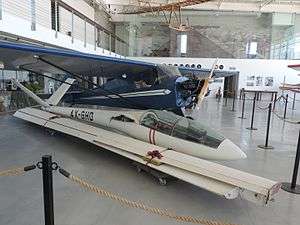Schreder HP-18
The HP-18 is a Richard Schreder-designed metal Racing Class sailplane that was offered as a kit for homebuilding during the 1970s and 1980s.[2]
| HP-18 | |
|---|---|
 | |
| An HP-18 dis-assembled prior to display at the Paradive Flight Gallery in Habonim | |
| Role | Club (formerly 15 metre) class Sailplane |
| Manufacturer | Homebuilt |
| Designer | Richard Schreder |
| Number built | 180 kits sold[1] |
Design and development
The HP-18 is a flapped (15-meter) sailplane featuring a V-tail and 90-degree flaps for glidepath control. The fuselage is composed of a prefabricated composite forward fuselage and a semi-monocoque aft fuselage, and features steeply reclined seating and a side-stick controller[2] although modifications using a conventional stick have been made.
Major features:
- Very low cockpit with reclining seating position
- Sidestick (changed to conventional stick by some homebuilders)
- Two-piece canopy (changed to single piece forward opening by some homebuilders)
- V-tail that folds upwards for easy storage
- Wing structure composed of spars with caps pre-machined from solid aluminium plate and aluminium wing skins bonded to closely spaced foam ribs
- Fiberglass fuselage pod, wing tip skids and tail fairings
- Aluminium tail cone
- Winglets added by some homebuilders
- Water ballast carried inside the hollow aluminium wing spars
- Typical Schreder trailing edge flaps/airbrakes partially interconnected with the ailerons
Variants
As most homebuilts, the HP-18 has been constructed with many variations in detail. Perhaps the most significant version is the Super HP-18 developed by Canadians Ed Hollestelle and Udo Rumpf, which features a modified wing airfoil, winglets, a front-hinged canopy, conventional control stick and higher ballast capacity.
Aircraft on display
- EAA Airventure Museum, Oshkosh, Wisconsin[3]
- National Soaring Museum, Elmira, New York[4]
- US Southwest Soaring Museum, Moriarty, New Mexico[5]
Specifications
General characteristics
- Crew: One pilot
- Length: 23 ft 2.4 in (7.07 m)
- Wingspan: 49 ft 2 in (15.00 m)
- Wing area: 113 sq ft (10.5 m2)
- Aspect ratio: 21.4
- Empty weight: 470 lb (213 kg)
- Gross weight: 970 lb (446 kg)
Performance
- Maximum speed: 150 mph (240 km/h, 130 kn)
- Maximum glide ratio: 38
- Rate of sink: 126 ft/min (0.60 m/s)
References
- Said, Bob: 1983 Sailplane Directory, Soaring Magazine, page 23. Soaring Society of America, November 1983. USPS 499-920
- Activate Media (2006). "HP-18 HP Aircraft, LLC". Archived from the original on 2008-03-03. Retrieved 2008-07-24.
- "Bryan/Harris HP-18 Sailplane". Archived from the original on 19 July 2011. Retrieved 28 March 2011.
- National Soaring Museum (2011). "Sailplanes in Our Collection". Retrieved 26 February 2011.
- US Southwest Soaring Museum (2010). "Sailplanes, Hang Gliders & Motor Gliders". Retrieved 26 May 2011.
- Schreder Designs webpage
- R Johnson, A Flight Test Evaluation of the HP-18W Sailplane, Soaring, July 2003